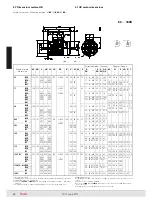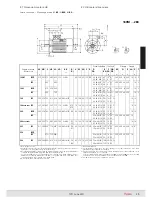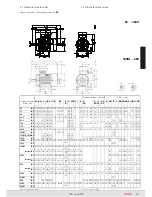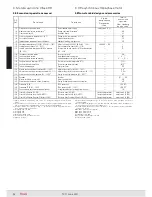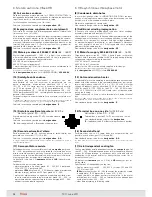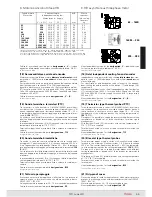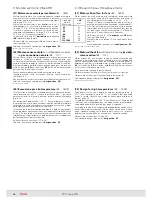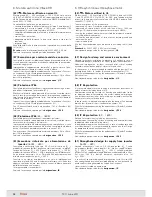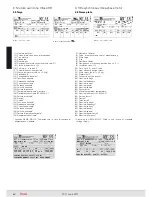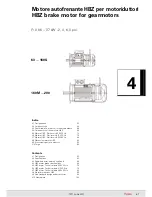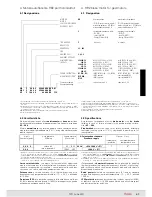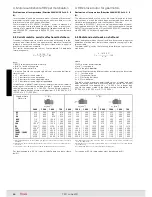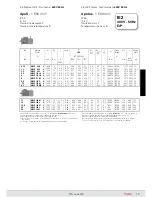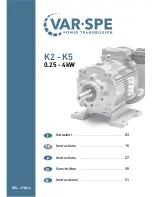
62
TX11 June 2011
Serie di motori autofrenanti con freno a c.c. – vasta e completa
per grandezza, polarità ed esecuzioni – destinata a un impiego
universale ma particolarmente appropriata per motoriduttori di
velocità
Classe di efficienza
IE1
(ErP), ove applicabile, di serie.
Classe di efficienza
IE2
(ErP),
Level 1A
(MEPS),
EISA Energy Effi-
cient
(EISA), a richiesta
Potenze 0,06 ... 37 kW
Singola polarità 2, 4, 6, 8 poli
230 Y 400 V 50 Hz (grandezze 63 ...
160S) e
400 V 50 Hz (grandezze 160M ... 200)
Grandezze 63 ... 160S anche con
potenze superiori
(contrassegnate
da *)
a quelle previste dalle norme
Classe isolamento F; classe sovratemperatura B per tutti i motori con
potenza normalizzata, F per i rimanenti
Forma costruttiva
IM B5
e derivate,
IM B14
(a richiesta) e
IM B3
(a
richiesta; grand. 63 ... 200 sempre predisposte) e corrispondenti forme
costruttive verticali;
tolleranze di accoppiamento in classe precisa
Protezione
IP 55
Costruzione
(elettrica e meccanica)
particolarmente robusta
per
sop portare le sollecitazioni termiche e torsionali alterne di avviamento
e di frenatura; cuscinetti adeguatamente dimensionati
Scudi e flange con
attacchi di serraggio
«
in appoggio
» e montati
sulla carcassa con accoppiamento «
stretto
»
Dimensionamento elettromagnetico opportunamente studiato per
consentire elevata capacità di accelerazione (
elevata frequenza di
avviamento
) e buona regolarità di avviamento
Idoneità al funzionamento con inverter
Guarnizioni d’attrito
senza amianto
Scatola morsettiera
ampia
e
metallica
, alimentazione freno indiffe-
rentemente
diretta
o
separata; raddrizzatore multitensione, unica
bobina freno, per tensione sempre coordinata con quella del
motore
(
sia
, sia
Y
)
Doppia superficie frenante, momento frenante proporzionato al
momento motore (normalmente
M
f
≈
2
M
N
) e registrabile a gradini
Massima silenziosità
e
progressività
di intervento (sia all’avvia-
mento che in frenata) grazie alla minore rapidità (tipica del
freno a
c.c.
) dell’àncora (più leggera e meno veloce nell’impatto): il motore
parte leggermente frenato quindi con maggiore progressività; buona
rapidità di sblocco e frenatura; possibilità di accentuare la rapidità alla
frenata, con apertura dell’alimentazione del lato c.c.
Elevata capacità di lavoro di frenatura
Ampia disponibilità di
esecuzioni per ogni esigenza
(volano, encoder,
servoventilatore, servoventilatore ed encoder, protezioni superiori a IP
55: IP 56, IP 65)
Particolarmente idoneo a impieghi nei quali sono richiesti frenate
e avviamenti regolari e silenziosi e, al tempo stesso, frenatura con
buona rapidità e precisione e numero elevato di interventi
Brake motors with d.c. brake – in a wide and comprehensive
range of sizes, poles and designs – for universal application but
specifically suitable for gearmotors
Efficiency class
IE1
(ErP), where applicable, as standard
Efficiency class
IE2
(ErP),
Level 1A
(MEPS),
EISA Energy Efficient
(EISA), on request
0
Powers 0,06 ... 37 kW
Single-speed 2, 4, 6, 8 poles
230 Y 400 V 50 Hz (sizes 63 ... 160S)
and
400 V 50 Hz (sizes 160M ... 200)
Sizes 63 ... 160S available also with
powers
(marked by*)
higher
than the ones foreseen by the standards
Class F insulation; temperature rise class B for all motors at standard
power, F for remaining motors
Mounting position
IM B5
and derivatives,
IM B14
(on request) and
IM B3
(on request; sizes 63 ... 200 always pre-arranged) and corresponding ver-
tical mounting positions;
mating tolerance under «accuracy» rating
IP 55
protection
Particularly strong construction
(both electrical and mechanical) to
withstand alternating torsional and thermic stresses of starting and
braking; duly proportioned bearings
«
Supported
»
tightening attachments
of endshields and flanges
fitted on housing with «
tight
» coupling
Electromagnetic sizing especially studied to allow high acceleration
capacity (
high frequency of starting
) and uniform starting
Suitable for operation with inverter
Asbestos-free
friction surfaces
Wide metallic
terminal box, possibility of
direct
or
separate
brake supply;
multi-voltage rectifier, one brake coil only, for voltage always co-ordina-
ted with motor
(
both
and
Y
)
Double braking surface, braking torque proportioned to motor torque
(usually
M
f
≈
2
M
N
) and adjustable per steps
Maximum reduced noise level
and operation
progressivity
(both at
starting and braking) thanks to a lower rapidity (
typical of d.c. brake
)
of the anchor (which is lighter and less quick in the impact): motor
starts slightly braked i.e. with greater progressivity; good release and
braking rapidity; possibility to increase rapidity when braking, with
supply opening on d.c. side
High braking capacity
Designs available for every application need
(flywheel, encoder,
independent cooling fan, independent cooling fan and encoder, protec-
tions higher than IP 55: IP 56, IP 65)
Particularly suitable for applications requiring regular and low-noise
starting and braking and, at the same time, braking with good rapidity
and precision and high number of starts
Normale
Standard
Encoder
Encoder
Servoventilatore
Independent
cooling fan
Servoventilatore
ed encoder
Independent cooling
fan and encoder
Volano
Flywheel
HBZ
Motore autofrenante con freno a corrente continua per motoriduttori
Brake motor with direct current brake for gearmotors
63 ... 160S
160M ... 200
* A richiesta.
* On request.
Summary of Contents for TX11 Series
Page 2: ......
Page 203: ...203 TX11 June 2011...

